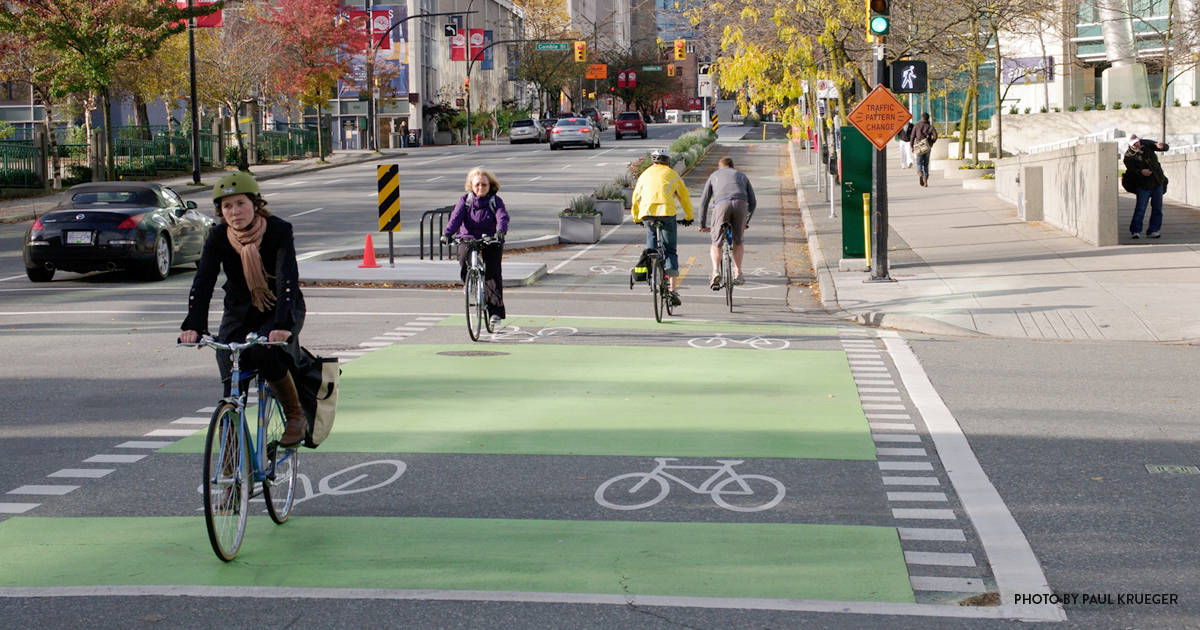Complete Streets Fact Sheet
Complete Streets is a national movement to promote inclusive roadway design that meets the needs of all users, including people of all ages and abilities riding bikes, waiting for the bus, or simply walking to get from one place to another.
CalBike, working in partnership with other transportation, environmental, and health advocacy organizations, has taken the lead to establish Complete Streets statewide in California.
What Are Complete Streets?
Complete Streets are designed and operated to enable safe access for all users. Pedestrians, bicyclists, motorists, and transit riders of all ages and abilities must be able to safely move along and across a Complete Street.
Complete Streets are an essential component of transportation equity. They are streets where buses can run on time because the lanes aren’t clogged with cars. Those who can’t afford an automobile still have the freedom to move safely and conveniently through their city on Complete Streets.
The recipe for creating a Complete Street varies depending on the setting. Important ingredients of Complete Streets include:
- Sidewalks that are wide enough to allow pedestrians to walk comfortably, separated from traffic.
- Bicycle lanes or paths that are safe for riders from 8 to 80 to feel comfortable to choose to ride.
- Street crossings that give time for elders and people with disabilities to cross with ease and that are safe for all users.
- Dedicated bus lanes to ensure that public transit stays on schedule and remains an attractive transportation option.
- Narrow travel lanes to slow auto traffic.
- Curb extensions, roundabouts, and other landscaping that increase safety and enhance the environment for those who walk and bike.
(Read more: Complete Streets FAQ, National Complete Streets Coalition)
Benefits of Complete Streets
Caltrans is well aware of the value of Complete Streets. It even created a Complete Streets Implementation Action Plan – then spent years ignoring its own directives. Here are the benefits of Complete Streets, in Caltrans’ own words:
- Increased Transportation Choices: Streets that provide travel choices can give people the option to avoid traffic congestion, and increase the overall capacity of the transportation network.
- Economic Revitalization: Complete streets can reduce transportation costs and travel time while increasing property values and job growth in communities.
- Improved Return on Infrastructure Investments: Integrating sidewalks, bike lanes, transit amenities, and safe crossings into the initial design of a project spares the expense of retrofits later.
- Quality of Place: Increased bicycling and walking are indicative of vibrant and livable communities.
- Improved Safety: Design and accommodation for bicyclists and pedestrians reduces the incidence of crashes.
- More Walking and Bicycling: Public health experts are encouraging walking and bicycling as a response to the obesity epidemic. Streets that provide room for bicycling and walking help children get physical activity and gain independence.
(Read more: Complete Streets Implementation Action Plan, Caltrans, Feb. 2010)
Complete Streets in California
In September 2008, Gov. Arnold Schwarzenegger signed into law Assembly Bill 1358, the Complete Streets Act, co-sponsored by the California Bicycle Coalition and AARP California, and authored by Assemblymember Mark Leno of San Francisco. AB 1358 required all cities and counties to consider all users of city- and county-owned roads when they update their general transportation plans. At the same time, the California Department of Transportation updated their own policies (see Deputy Directive 64) to apply the same “complete streets” philosophy to state-owned roads. Unfortunately, despite AB 1358, plenty of advocacy, and their own directive, Caltrans routinely fails to make complete streets safety improvements when repaving streets they own. They indeed consider safety improvements, per policy, but too often they summarily reject the idea. “We thought about it, but making safety improvements would slow down car traffic so we rejected the idea,” is the common refrain.
SB 127: Holding Caltrans to Account
Two years ago, Senator Scott Wiener authored a bill to hold Caltrans accountable for including Complete Streets in its repaving and repair projects. The bill did not advance because the priority in the Senate was increasing the gas tax and road fees to pay for repaving. (That was the perfect time to make sure we were using that money wisely, we thought, but a majority of senators disagreed.) Last year, the same bill died in committee because of the threat of Proposition 6, which would have rescinded the road funding increases. Now that voters have resoundingly defeated Proposition 6, we believe the time is ripe for a Complete Streets law that will transform our streets for the better, in the most efficient way possible.
In January of 2019, Senator Wiener re-introduced the bill to strengthen California’s complete streets requirements. The Complete Streets for Active Living Bill, SB 127, will flip the script and mandate the inclusion of bike and walk facilities in any Caltrans rehabilitation project unless Caltrans holds a public hearing where they justify an exception to the requirement. CalBike and our partners are now hard at work on continuing our Complete Streets Campaign.
More Complete Streets Resources
Learn more about our Complete Streets Campaign.
Sign our petition to show your support for Complete Streets.
- Read the full text of SB 127, as introduced on April 30, 2019
- Read the full text of Assembly Bill 1358, as chaptered on Sept. 30, 2008
- Read General Plan Update Guidelines for AB 1385
- Learn about the Caltrans Complete Streets Implementation Plan
- Learn about the nationwide Complete Streets movement at https://smartgrowthamerica.org/program/national-complete-streets-coalition/






